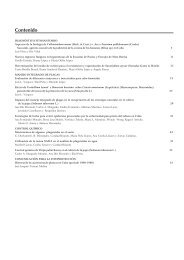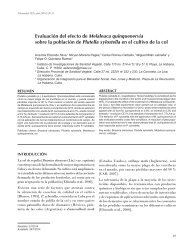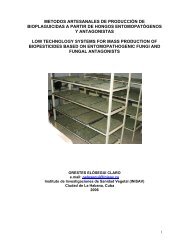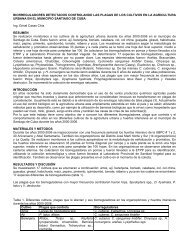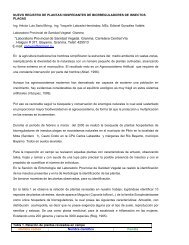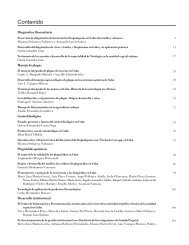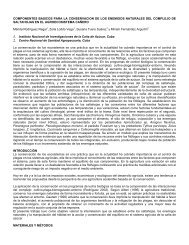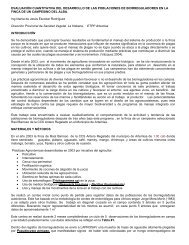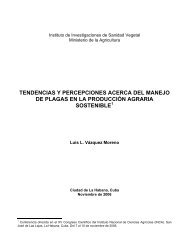2 - Instituto de Investigaciones de Sanidad Vegetal
2 - Instituto de Investigaciones de Sanidad Vegetal
2 - Instituto de Investigaciones de Sanidad Vegetal
You also want an ePaper? Increase the reach of your titles
YUMPU automatically turns print PDFs into web optimized ePapers that Google loves.
PRONÓSTICO DEL TIZÓN TARDÍO (PHYTOPHTHORA<br />
INFESTANS (MONT.) DE BARY) DE LA PAPA EN CUBA.<br />
II. EVALUACIÓN DE LA EFECTIVIDAD DEL MODELO<br />
NAUMOVA MODIFICADO<br />
Guadalupe Gómez, Magaly Suárez, Moisés Figueroa, Teresa Rivero y Alexis Hernán<strong>de</strong>z<br />
<strong>Instituto</strong> <strong>de</strong> <strong>Investigaciones</strong> <strong>de</strong> <strong>Sanidad</strong> <strong>Vegetal</strong>. Calle 110 no. 514 e/ 5a. B y 5a. F, Playa,<br />
Ciudad <strong>de</strong> La Habana, CP 11600<br />
RESUMEN<br />
El <strong>Instituto</strong> <strong>de</strong> <strong>Investigaciones</strong> <strong>de</strong> <strong>Sanidad</strong> <strong>Vegetal</strong> <strong>de</strong> Cuba implementó<br />
en 1977 la metodología <strong>de</strong>l Nomograma <strong>de</strong> Naumova en las<br />
Estaciones Territoriales <strong>de</strong> Protección <strong>de</strong> Plantas con el objetivo <strong>de</strong><br />
hacer pronósticos <strong>de</strong> primeras apariciones y <strong>de</strong>sarrollo <strong>de</strong>l tizón tardío<br />
<strong>de</strong> la papa en Cuba. Debido a ciertas imprecisiones este mo<strong>de</strong>lo fue<br />
ajustado a las condiciones climáticas <strong>de</strong> la isla. No obstante, en <strong>de</strong>terminadas<br />
localida<strong>de</strong>s y campañas, el método no alertaba el surgimiento<br />
<strong>de</strong> las primeras manchas. Mediante la evaluación <strong>de</strong>l mo<strong>de</strong>lo <strong>de</strong>s<strong>de</strong><br />
1978-1979 hasta 1992-1993 en diferentes zonas <strong>de</strong> las provincias <strong>de</strong><br />
La Habana, Matanzas, Cienfuegos, Villa Clara y Ciego <strong>de</strong> Ávila, y <strong>de</strong><br />
la <strong>de</strong>terminación <strong>de</strong> su eficacia se logró valorar sus <strong>de</strong>ficiencias. En la<br />
mayoría <strong>de</strong> los casos en que el método no alertó y la enfermedad fue<br />
<strong>de</strong>tectada coincidió con un solo día <strong>de</strong> condiciones favorables acompañado<br />
<strong>de</strong> una <strong>de</strong>terminada cantidad <strong>de</strong> lluvias. El porcentaje <strong>de</strong> coinci<strong>de</strong>ncia<br />
osciló entre 86,50 y 33,33%, con un valor general <strong>de</strong> 71,02%,<br />
concluyéndose a<strong>de</strong>más que la <strong>de</strong>ficiencia principal que tiene el mo<strong>de</strong>lo<br />
es la no-cuantificación <strong>de</strong> las precipitaciones.<br />
ABSTRACT<br />
Plant Health Research Institute of Cuba put into practice in 1977 a Nomograma<br />
Naumova method to forecasting about the first apparition<br />
and <strong>de</strong>velopment of potato late blight. This method was adjusted to climatic<br />
condition of Cuba. However, it didn’t work well in some localities<br />
and growing seasons. It was evaluated since 1978-79 until 1992-93 in<br />
different places of Havana, Matanzas, Cienfuegos, Villa Clara and<br />
Ciego <strong>de</strong> Avila provinces. It was <strong>de</strong>termined its efficacy and was validated<br />
the <strong>de</strong>ficiencies of the method. In the most cases where the method<br />
was unable to alert both favourable conditions and rain.<br />
Coinci<strong>de</strong>nce percentage ranged between 86.50 and 33.33% with a<br />
general mean of 71.02%. This paper conclu<strong>de</strong>d that weak point of this<br />
mo<strong>de</strong>l is the lack of rain quantification.<br />
Key word: P. infestans, potato late blight, S. tuberosum, forecasting.<br />
Palabras clave: P. infestans, tizón tardío, S. tuberosum, pronóstico.<br />
INTRODUCCIÓN<br />
A partir <strong>de</strong> la creación en Cuba en 1975 <strong>de</strong> las Estaciones<br />
Territoriales <strong>de</strong> Protección <strong>de</strong> Plantas (ETPP)<br />
como parte <strong>de</strong>l Sistema Estatal <strong>de</strong> <strong>Sanidad</strong> <strong>Vegetal</strong>,<br />
diversas metodologías <strong>de</strong> señalización y pronóstico<br />
fueron establecidas por parte <strong>de</strong>l <strong>Instituto</strong> <strong>de</strong> <strong>Investigaciones</strong><br />
<strong>de</strong>l propio sistema [IISV, 1978]. En el caso<br />
<strong>de</strong>l tizón tardío <strong>de</strong> la papa el método seleccionado fue<br />
el Nomograma <strong>de</strong> Naumova [Zhumakov, 1970], el<br />
cual <strong>de</strong>fine la ocurrencia <strong>de</strong> «períodos críticos» favorables<br />
para el <strong>de</strong>sarrollo <strong>de</strong> la enfermedad. Sin embargo,<br />
se <strong>de</strong>tectó que en <strong>de</strong>terminados casos la enfermedad<br />
aparecía en ausencias <strong>de</strong> períodos críticos en forma <strong>de</strong><br />
brotes ligeros en las partes bajas y húmedas <strong>de</strong> los campos<br />
y que generalmente no <strong>de</strong>sarrollan a epi<strong>de</strong>mia, <strong>de</strong><br />
forma que se ajustó el mo<strong>de</strong>lo a las condiciones <strong>de</strong><br />
Cuba y el nuevo mo<strong>de</strong>lo fue <strong>de</strong>nominado Naumova<br />
Modificado por Rodríguez (1989), trabajo publicado<br />
recientemente por Gómez et al. (1999). En la campaña<br />
<strong>de</strong>l cultivo 1993-1994 el tizón tardío tuvo un<br />
comportamiento inusual, el patógeno fue extremadamente<br />
agresivo, fundamentalmente en La Habana<br />
y Matanzas, don<strong>de</strong> se <strong>de</strong>molieron 58 caballerías por<br />
su causa [Gómez et al., 1995], y en esa misma década<br />
otras campañas tuvieron características similares,<br />
y no en todos los casos el mo<strong>de</strong>lo hizo<br />
predicciones acertadas, fundamentalmente cuando<br />
posterior a un solo día con condiciones favorables la<br />
lluvia alcanzaba valores elevados, por lo que se evaluó<br />
su eficacia con el objetivo <strong>de</strong> precisar los puntos débiles<br />
<strong>de</strong>l método.<br />
fitosanidad/35



